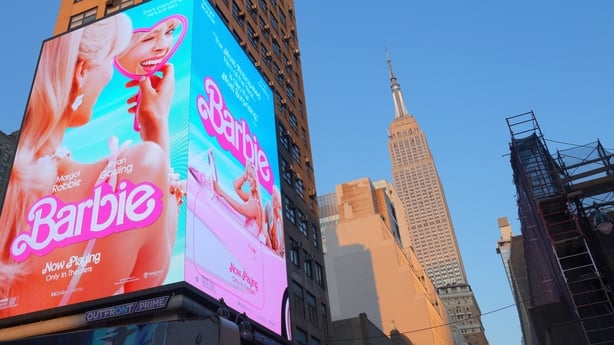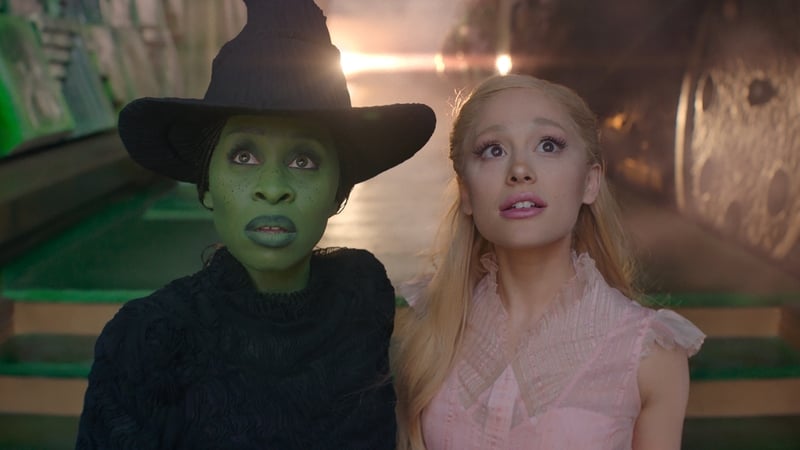It’s been a tricky time for cinemas.
Last year the global film box office generated $32.2 billion in revenue – which is down around 3% on 2023. And that’s notable because it’s the first time since the pandemic that box office revenues have fallen year on year.
But it also means that the industry is even further away from the post-pandemic recovery that many have been hoping for. Revenues back in 2019 were around $42.5 billion, which means last year’s take was more than 24% lower than the pre-pandemic peak.
Unlike most other industries, film is still carrying a pandemic hangover – and bear in mind that most countries have seen quite significant inflation in the years since then, so really revenues would need to be reasonably higher than $42.5 billion now in order to even be on a par in real terms with the 2019 take.
Why has cinema not recovered since the pandemic?
It is worth giving a bit of context to those figures, because 2019 is a particularly tough year to compete with.
That year there were eight films that took in more than $1 billion at the box office – including Avengers: Endgame, which took in nearly $2.8 billion on its own, That made it the second highest grossing film of all time.
(By the way, seven of the eight billion-dollar movie releases in 2019 were Disney films – showing just how dominant that studio was in particular in the year.)
So 2019 was a big year for cinema, with lots of blockbusters – which tend to be the films that bring in the big bucks. And that means it was always going to be a hard act to follow.
And some argue that 2024 was always going to be a weak year for cinema, because of the Hollywood writers strike. That took place across 2023, and it ended in late September of that year – but the knock-on effects of it lasted much longer. Because the strike delayed releases, it put productions on hold, and it led to a pause on the development of new films. And even when there was an agreement, it took time for the movie industry machine to get back up and running again.
As a result the release schedule, certainly for the first half of 2024, was fairly threadbare – which obviously had a knock-on effect on ticket sales.
If you look at the North American box office, for example, 2024 revenues were 4% lower compared to 2023 – so pretty much on a par with the global decline. But some in the industry were probably relieved with that figure because, in the January to June period, sales were down 27.5% year on year. It had at one stage looked like 2024 would be a disaster for the film industry, until big releases like Inside Out 2, Deadpool & Wolverine and Moana 2 came along to soften the blow. They each took in more than $1 billion globally (and they were all Disney, too, by the way).
The hope within the movie industry would be that now, with a normal, full release schedule for the whole year, things should pick up again in 2025.
But people’s habits have definitely changed…

Oh absolutely – it’s been a painfully slow post-pandemic recovery for cinema – and it’s clearly still ongoing.
In the early stages people hoped that weak sales were just a result of nervousness around being in a confined space with strangers, but as time has gone on it’s become clear that there’s more to it. Because people have gotten more comfortable with staying at home and watching movies there. More and more people now have a decent sized-TV, they might even have a decent sound system, and honestly they’re finding that experience more enjoyable than going out.
And there are lots of obvious reasons for that – when you’re home you can pause what you’re watching if you need to go to the toilet. Or if you want to make a cup of tea. And best of all, you don’t have to worry about sitting behind the guy who can’t stop checking his phone, or in front of the couple that won’t stop talking.
And it’s probably a lot cheaper too – chances are you can download a new release or even get a month’s subscription to a streaming service for less than a couple of cinema tickets.
And that’s part of the difference now, too, because there’s just so much choice within reach in your living room now. Most people probably have lots of films – and film-quality TV – in their Netflix and Disney+ watchlist that they just haven’t found time to watch yet. Not to mention all of the digital downloads available to buy or rent with minimal effort.
So if people have all of this content that they want to watch right there, why would they go out to pay to watch something else entirely?
And film studios have enabled this in a lot of ways – because they’ve dramatically shortened the window between a cinema release, and a home video release. In the case of streamers like Netflix, you know it won’t be long before what’s in the cinema is available at home (and you already have a subscription so it technically won’t cost you any more to watch).
And that means that even when there is a new cinema release people want to see – they know that they won’t have to wait very long until they can watch it at home.
So what are studios doing to get people back to cinemas?

Well it’s an interesting one because cinemas have come under threat time and again through the years – and they’ve always found a way to survive.
People thought the industry was cooked when TVs started becoming common in households from the 50s onwards but cinema innovated and stayed attractive – by offering amazing things like Technicolor. Then as colour TVs started to take over, people started writing the obituary for cinema again but it remained relevant; in part by relying on big, epic movies that just didn’t look good on a small CRT.
And it’s managed to navigate everything from home video, to HD and 4K TV – with the big blockbusters often being the thing that kept people coming in. Those are the films where people felt like they had to go to the cinema to get the real experience.
But blockbusters have not been the saviour this time around.
There have been some very lucrative ones – but there have been a lot of flops too. For all its recent successes, Disney also lost upwards of a billion dollars through a string of flops including Lightyear, The Marvels, the last Indiana Jones movie and Wish. Blockbusters, by their nature, cost a lot of money to make – but the fact that they’re not guaranteed to get people out means they’ve become a much riskier proposition today.
Instead what we’re seeing tending to do well are family movies – like Moana 2 and Despicable Me 4. Dog Man is one of the highest box office earners so far this year (though that will probably change once we hit the summer).
That points to the pester power of kids – but also the fact that parents will use the cinema as a rainy day outing, a little treat or just a way to try to keep the kids entertained for an hour or two. Despite the fact that they have Netflix and Disney at home.
The other big successes have been what you might call event films – and these are releases that manage to create some kind of bigger movement around them, and maybe connect with some underlying fandom that already exists.
Barbie is a great example of that – it became a viral sensation in 2023 in no small part due to the pre-existing love of the brand and some clever marketing. In the end the audience ended up doing a lot of the marketing for the movie for free.
A more recent example of this trend has been Wicked – which obviously had an inbuilt fanbase through the musical. That led to a phenomenon where people dressed up to go to the cinema and – because they already knew the songs – they could sing along while they were there.
(It was no harm that there was also this really compelling press tour with Cynthia Erivo and Ariana Grande which helped build the hype.
So what are cinemas doing to capitalise on this?

The idea of cinema as an event is really catching on – beyond the handful of films that have been able to create that kind of buzz around themselves. And cinemas are increasingly dedicated screens to something other than the latest movie releases.
Concert movies and live music is a good example of that – the cinema release of Taylor Swift’s Era’s Tour concert took in $260m at the box office back in 2023. More recently we’ve seen Talking Heads’ iconic ‘Stop Making Sense’ get a global cinema release to mark its 40th anniversary. Cinemas are also increasingly streaming live concerts, plays, operas and musicals too – the idea being that, even if you couldn’t get a ticket or couldn’t afford to travel overseas for the show itself, you can still watch it live, and as part of an audience.
They’re also showing a lot more classic films – maybe to mark an anniversary, or as part of a kind of informal season of films based around a genre, or a particular director, or actor. Or sometimes they’re just responding to the fact that these films have developed an ironic fanbase, or have become known to a new generation through gifs and memes.
They’re also tapping into the fandom that exists around certain films – for example, by hosting a 13 hour marathons of the Lord of the Rings Extended Edition trilogy.
And they’re trying to find more interactive events to stage in cinemas – for example, vThe Lighthouse in Dublin’s Smithfield is this month hosting a ‘solve-along-a-Murder She Wrote’, which promises – amongst other things – a theme tune singalong, a Cabot Cove quiz, and a competition to see who can spot the murderer first.
How else are cinemas changing?

Well some are actually investing quite heavily in order to make themselves more attractive to audiences – after all, they’re now competing with everyone having a decent TV and a comfy couch in their living room.
AMC Theatres in the US late last year announced plans to invest $1.5 billion over the next four to seven years, with a view to improving the quality of picture, and of sounds in their cinemas. And other major cinema chains there are planning to make similar investments.
Part of the focus will also be on the premium experience – so more comfortable seats, more leg-room, and so on.
Meanwhile most cinema chains here offer some kind of scheme where you can get unlimited, or close to unlimited, access to films in return for a monthly fee. Some are also offering discounted ticket prices on a regular basis – in the hope that they can get customers in and then make a profit on the food and drink.
But it’s not all about the major multiplexes, either, we’re also seeing the growth of smaller, niche cinemas too. That includes places that maybe offer proper meals and cocktails, rather than just popcorn and soft drinks. And again, that’s all about creating an experience that goes beyond what they see on the screen – because they can almost get that anywhere now. It’s not about making it a more enjoyable day or night out in general.




